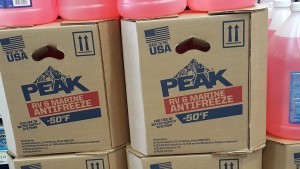So common you many notice them let alone be aware that they are a package marking required by the hazardous Material Regulations of the PHMSA/USDOT: Package orientation arrows. The purpose of this article is to explain the requirements for the use of the package orientation arrows at 49 CFR 172.312 and §173.25.
The requirement to display package orientation arrows is only one of two responsibilities detailed in §172.312, though it is the more critical of the two to shippers of hazardous materials.
49 CFR 172.312 is entitled Liquid hazardous materials in non-bulk packagings and is located in Subpart D - Marking of Part 172, so, though not clear from its title, it pertains to the marking requirements for liquid HazMat in non-bulk packagings.
§172.312(a) clarifies the applicability of this section to the following three types of packagings:
1. A non-bulk combination packaging with inner packagings containing liquid hazardous materials.
So that’s…
- Non-bulk packaging: basically, ≤119 gallons maximum capacity. Read more about bulk and non-bulk packaging.
- Combination packaging is defined at §171.8:
Combination packaging means a combination of packaging, for transport purposes, consisting of one or more inner packagings secured in a non-bulk outer packaging. It does not include a composite packaging.
- With inner packagings of a liquid hazardous material.
- And…a hazardous material shipped as a Limited Quantity is not excepted from compliance with §172.312 (04-0123).
2. A single packaging fitted with vents.
So that’s…
- Single packaging is defined at §171.8:
Single packaging means a non-bulk packaging other than a combination packaging.
- HazMat may be a liquid or a solid.
- And…a pressure relief device on a packaging is not a vent (07-0028).
|
Like this article? Subscribe to my Monthly Newsletter No marketing emails! |
3. An open cryogenic receptacle intended for the transport of refrigerated liquefied gases.
So that’s…
Refer to PHMSA interpretation letter 07-0028 for some clarity on what is meant by a cryogenic receptacle and a refrigerated liquefied gas.
If you are offering for transportation one of the above packagings, it must comply with the two requirements of §172.312(a):
- Packed with its closures upward.
- Marked on two opposite vertical sides with the package orientation arrows (arrows pointing in the correct upright direction).
Package orientation arrows must appear similar to the illustration shown in §172.312(a), and:
Arrows must be black or red.
- Background must be white or other suitable contrasting background.
- No minimum or maximum size is indicated. However, the arrows must be in proportion to the size of the packaging.
- A rectangular border is optional.
Pursuant to 49 CFR 172.312(b), package orientation arrows can’t be used on a package containing a liquid HazMat if they are displayed for any reason other than proper package orientation (00-0027). Unless the arrows displayed are “sufficiently distinct” from those required by this regulation (04-0252). However, nothing prevents the use of arrows on the packagings of non-hazardous materials or even on HazMat packagings not subject to §172.312, e.g. solid hazardous materials (03-0238).
The requirements of 49 CFR 172.312(a) – see above – don’t apply to the following:
- A non-bulk packaging with inner packagings that are cylinders.
Cylinder means a pressure vessel designed for pressures higher than 40 psia and having a circular cross section. It does not include a portable tank, multi-unit tank car tank, cargo tank, or tank car.
- Non-bulk combination packagings containing inner packagings of Class 3 Flammable Liquids of ≤1 liter shipped by highway, rail, or vessel – not air – as a Limited Quantity [§173.150(b)] or Consumer Commodity [§173.150(c)].
- Non-bulk combination packagings containing liquid inner packagings of ≤120 mL (4 fl oz) when shipped by air, if sufficient absorbant material is used to completely absorb the liquid contents.
- Liquids contained in manufactured articles (e.g. alcohol or mercury in thermometers) which are leak-tight in all orientations.
- A non-bulk package with hermetically sealed inner packagings of ≤500 mL each.
- Packages containing liquid Infectious Substances (Division 6.2) in primary receptacles of ≤50 mL (1.7 oz).
- Class 7 Radioactive Material in Type A, IP-2, IP-3, type B(U), or Type B(M) packages.
That is the extent of the requirements of 49 CFR 172.312, but it is not the end for the use of package orientation arrows.
|
Contact me with any questions you may have about the transportation of hazardous materials by air, highway, vessel, or rail International and Domestic Daniels Training Services 815.821.1550 |
Use of Package Orientation Arrows on Overpacks:
49 CFR 173.25 describes the requirements of the HMR for shipping hazardous materials in an overpack, §173.25(a)(3) pertains specifically to the use of package orientation arrows:
Each package subject to the orientation marking requirements of §172.312 of this subchapter is packed in the overpack with its filling holes up and the overpack is marked with package orientation marking arrows on two opposite vertical sides of the overpack with the arrows pointing in the correct direction of orientation.
So, a HazMat packaging that is required to display package orientation arrows (see §172.312) when placed in an overpack must comply with the following:
- Packed so that its filling holes (i.e. where liquid enters the packaging) is on top.
- The overpack is marked with package orientation arrows on two opposite vertical sides indicating the correct vertical orientation. The package orientation arrows must be displayed on the overpack even if the arrows on the HazMat packages are visible through the overpack, e.g. boxes shrink-wrapped to a pallet (10-0144).
Package orientation arrows are not required on salvage drums even if the inner packaging is required to display the arrows [§173.3(c)].
When preparing hazardous materials for transportation be sure not to overlook something as simple, though important and required by the HMR, as the package orientation arrows. Please contact me if you have any questions about the package orientation arrow marking, the Hazardous Material Regulations, or if you require HazMat Employee Training.

